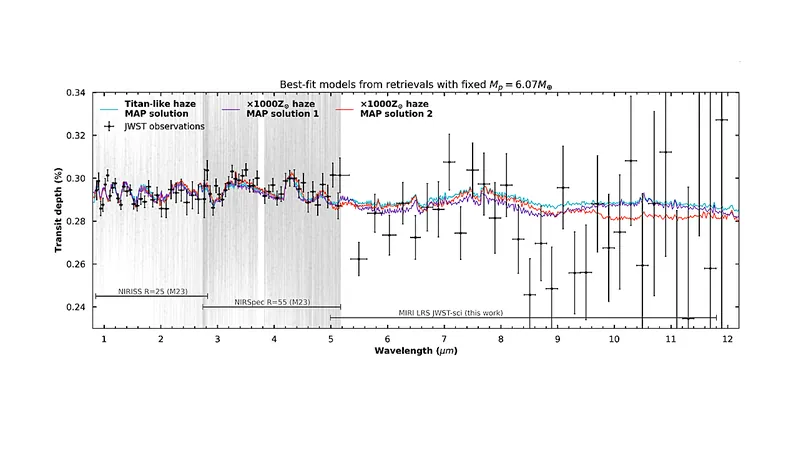
K2-18b: A Diplomatic Discovery in Exoplanet Atmospheres
2025-09-16
Author: Wei
K2-18b: A Hidden Gem in Our Cosmic Neighborhood
Meet K2-18b, an intriguing sub-Neptune exoplanet that's stealing the spotlight in the quest for extraterrestrial possibilities! Nestled in the habitable zone of its star, this intriguing orb has piqued the interest of astronomers, especially after compelling new data from the James Webb Space Telescope (JWST) unveiled its atmospheric secrets.
Unveiling the Atmosphere with Cutting-Edge Technology
While Hubble Space Telescope's earlier observations laid the groundwork, JWST’s capabilities have taken our understanding to new heights! Researchers have meticulously analyzed transit spectra, merging fresh MIRI LRS data with insights from NIRISS/NIRSpec, creating a comprehensive picture of this enigmatic planet's atmosphere.
What Lies Beneath: The Density and Composition of K2-18b
With updated stellar parameters, scientists have calculated K2-18b’s density at approximately 3.34±1.44 g/cm³. This measurement is crucial for discerning the planet's composition.
Shrouded in Mystery: Haze and Chemical Makeup
Delving deeper, researchers explored the effects of haze on K2-18b’s atmosphere. Their findings indicate an atmosphere dominated by hydrogen (H2) with traces of hydrocarbon hazes, suggesting a complex interplay of chemical interactions without the need for instrumental adjustments. The mean molecular weight of the atmosphere hovers around 2.4 Daltons.
Temperature Tuning: A Dramatic Shift in Findings
Interestingly, while previous studies proposed cooler atmospheric temperatures, this new analysis suggests that K2-18b may be 100-200 K warmer, although cooler estimates remain plausible depending on the planet’s mass.
A Call to Arms: More Research Needed!
The journey doesn't end here! The research team urges further studies, particularly self-consistent photochemical and microphysical modeling, alongside additional mid-infrared observations to better understand the essential hydrocarbon species.
The Team Behind the Breakthrough
This groundbreaking work has been spearheaded by dedicated scientists including Ruohan Liu, Panayotis Lavvas, Giovanna Tinetti, Jesus Maldonado, Sushuang Ma, and Arianna Saba, all pushing the boundaries of our cosmic knowledge!




 Brasil (PT)
Brasil (PT)
 Canada (EN)
Canada (EN)
 Chile (ES)
Chile (ES)
 Česko (CS)
Česko (CS)
 대한민국 (KO)
대한민국 (KO)
 España (ES)
España (ES)
 France (FR)
France (FR)
 Hong Kong (EN)
Hong Kong (EN)
 Italia (IT)
Italia (IT)
 日本 (JA)
日本 (JA)
 Magyarország (HU)
Magyarország (HU)
 Norge (NO)
Norge (NO)
 Polska (PL)
Polska (PL)
 Schweiz (DE)
Schweiz (DE)
 Singapore (EN)
Singapore (EN)
 Sverige (SV)
Sverige (SV)
 Suomi (FI)
Suomi (FI)
 Türkiye (TR)
Türkiye (TR)
 الإمارات العربية المتحدة (AR)
الإمارات العربية المتحدة (AR)